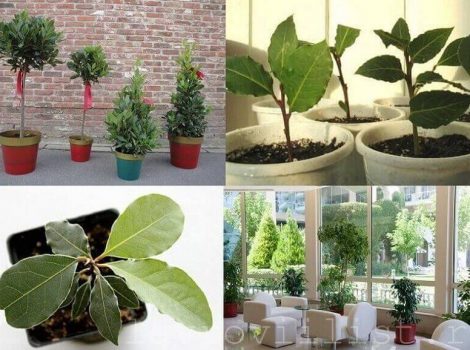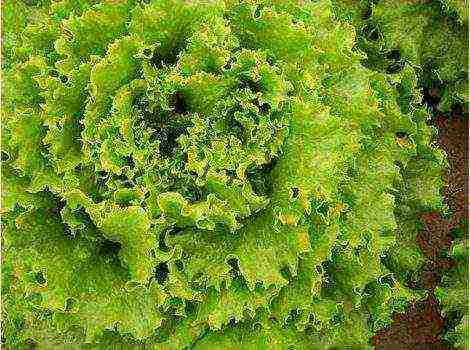Content

How many of us carry out daily quartzing of premises?
Almost nobody.
But the lemon tree, with the help of its phytoncides, constantly purifies the air in the apartment of those who have such a houseplant.
The famous English proverb "Eat an apple a day and do without a doctor" was most likely a rework of the proverb of Indian yogis /
A lemon a day - and you will be healthy. Indeed, lemon is, if not a panacea, then one of the main prophylactic agents for diseases of a purely "apartment" property, that is, associated with stagnant air in the room, its dryness, etc.
Lemon is another fruit!
Lemon turned out to be the most fertile of southern plants. in room culture, bearing fruit even on the northern windows, that is, with a lack of light. But not just any kind of lemon, namely its indoor variety. For example, you can plant a stone from the fruit of a lemon bought in a store, but this tree will grow for a long time and if it gives fruit, they will be bitter and completely unlike those in the store.
Lemon generally has one strange property: seedlings obtained from seeds bloom in the 10-15th year of cultivation, and rooted cuttings - already in the 3-4th year. But the seed bush is more durable and unpretentious, and the cuttings can be capricious and throw off all the leaves, or even dry out.
In the markets, you can sometimes find cuttings of lemons brought from the Russian Caucasus, Georgia, Armenia, and even from Turkey, Israel, Egypt. It should be remembered that these are varieties of open ground, poorly flowering and even poorly vegetating in indoor conditions. Therefore, it is necessary to purchase exactly varieties for room culture. The most famous is the Pavlovsky lemon variety - a fruit with a large apple.
Slightly less fruit in the "Panderoza" variety, larger - in the "Mayer". Dwarf forms of woody varieties "Novogruzinsky" and "Maikopsky" were bred 8 separate lines and multiplied vegetatively - they also withstand the pot culture, but are more affected by pests. The varieties of the "Uralsky" line were bred, which bear fruit well with a short daylight hours.
See also: Lemon in a pot - growing and care
Seed propagation of homemade lemon
Citrus fruits are bad for overdrying seeds - seeds that have just been or recently removed from the fruit should be planted in the substrate. Seeds are planted only from fruits ripened in room culture.
Store-bought peat substrates are not suitable for sowing. The soil should be neutral or slightly alkaline. It is better to use compost or leaf humus taken from the trunks of lindens, birches, maples (but not oaks, spruces, pines). This organic-rich soil is mixed in equal parts with coarse sand.
Add about 10% (by volume) crushed hardwood coal. The substrate is mixed, poured into a container, watered abundantly, put in a plastic bag. It is tied to form a closed volume, placed in a microwave and heated at full power for 10 minutes - this completely disinfects the substrate. After that, he is allowed to cool and excess moisture evaporate.
For sowing, you can use any plastic container with a lid - you need a microclimate with high humidity. Either drain holes are made in the container, or a drainage layer (expanded clay, fine gravel, charcoal) 2 cm thick is poured. The substrate is laid with a layer of about 5 cm, watered and loosened after the water leaves.
The seeds are planted to a depth of -1 cm. They are sprinkled with earth and lightly pressed so that the substrate adheres tightly to the peel. The container is closed with a lid and placed in a semi-dark place at t - 22-24 ° C. Germination begins in about a month. Seedlings are gradually taught to light. When 3-4 leaves appear, the seedlings are transplanted from the container into deeper pots.

Propagation of lemon by cuttings
For grafting, cut the semi-lignified branches of indoor lemons. The crowns of lemon trees are periodically formed - cuttings do not harm them. There should be 3-4 buds on the handle. The lower leaves are cut completely (not torn off), and the upper leaf is cut in half to reduce the evaporation area.
They are planted in coarse river sand, which is pre-boiled in water or heated in a microwave oven. 10% (by volume) of crushed coal is added to the sand. Take a higher container for cuttings (about 15 cm high). A layer of drainage (2 cm) and a layer of substrate (prepared as for seed reproduction) of 5 cm are laid on the bottom. The rest of the container is covered with prepared sand mixed with coal, without bringing about 1 cm to the top, and watered.
The cuttings are sprinkled with crushed coal, gray, aluminum powder. The processing of sections with medicinal greenery has proven itself well. The top cut can be sealed with garden varnish or wax. The cuttings are stuck into the sand at an angle of -15 ° so that the upper bud with a part of the leaf is at a height of 3-5 cm above the substrate.
Stimulating rooting with auxin hormones can accelerate rooting, but their concentration is important. Of those that are on sale, the most effective powder preparation is "Kornevin". Tablets -Heteroauxin "dissolve poorly in water, so at first they are diluted in a small volume of vodka and only then in water. The concentration of hormones used is the same as for rose cuttings.
The container is closed with a lid or placed in a transparent bag, covered with a cut-off plastic bottle, and placed under diffused lighting at t = 24-28 ° C. When mold appears, the cuttings are sprayed with a soapy solution of oven ash or soda infusion. Airing reduces the likelihood of fungal attack, but inhibits rooting. Therefore, after airing, the cuttings need to be watered and even sprayed. Always watered with settled, slightly warm water. To do this, it is convenient to hold containers with irrigation water (ordinary plastic bottles) on the central heating batteries and cool them, if necessary, an hour before watering.
After rooting, 3-4 leaves are expected to appear on the young shoot and the first transplant is carried out.
See also: Growing lemon at home, indoors or in a greenhouse
Homemade lemon care
Both seedlings and cuttings are transplanted once a year. This is important as citrus fruits like slightly alkaline soil. When watering with tap water, the alkalinity of the soil increases significantly over the year. Therefore, the substrate is prepared fresh every time, and the old one is disposed of. The composition of the substrate is the same as for seedlings, but it is slightly heavier (by 10-20%) by adding loamy gray earth or garden soil.
Adult plants are transplanted every 8 3-4 years. At the same time, rotten roots are removed, the sections are disinfected. The volume of the pot is always taken with a margin, since young roots grow rather horizontally and quickly rest against the walls of the pot - while in the free substrate, branching of the roots is stimulated. When there is not enough substrate, root branching does not occur and the plant stops growing.
Lemon can withstand partial shade and wintering in indoor conditions.With a visible cessation of growth (hibernation), the intensity of irrigation is reduced, but the spraying does not stop - the dry air when the central heating is operating is destructive for citrus fruits.
In summer, citrus fruits are given a "vacation": they are taken out onto the balcony or transported to the country house. Lemon does not really need a "vacation", but the fresh summer air will not harm it. Plants are accustomed to the sun gradually, at first shading them with light lutrasil.
Reddening of the foliage indicates an excess of sunlight. Closer to autumn, the plants also gradually accustom them to the microclimate of the apartment, at first bringing them into the room only for the night.
Lemon usually has self-pollinated flowers. Long bloom - up to 2 months. In a lemon, the fruit that has set can ripen for more than six months, depending on the variety. Ripe fruits have a thin skin and a strong aroma.
Before flowering, it is advisable to feed the lemon with phosphorus fertilizers. An excess of nitrogen fertilizers reduces the intensity of flowering, but increases the rate of growth of the green mass.
If the lemon is periodically transplanted into the aforementioned fertile substrate, you should not carry out frequent dressings. If you use peat substrates, the fertility of which fades away in six months, then the plants find themselves, as it were, in the conditions of a substrate hydroponic culture and require constant feeding with complex macro- and microelement fertilizers once a week.
Reference by topic: How to make a lemon in a room bear fruit
Growing lemon at home from a stone - video
Growing lemon from seed 2
Below are other entries on the topic "Cottage and garden - do it yourself"
Exotic plants at home - how to plant and grow: How to grow at home ... Vanilla (sweet) lemon - growing varieties: Sweet lemon - Vanilla variety: ... The most unpretentious varieties of lemons - Panderoza, Pavlovsky and Limoncello: Panderoza, Pavlovsky and Limoncello - ... Reproduction by air layering - how is it correct ?: How plants are propagated by air layering “There is ... Caring for lemon and banana growing in indoor conditions: How to properly care for lemon ... Grapes: works in June: Caring for grapes in June In ... Onion fly - how to get rid of: Fighting onion fly - ...
.
Some indoor plant lovers have adapted to growing citrus trees on the windowsill. Lemon is especially popular. Growing lemon at home will not take a lot of energy from the owner.
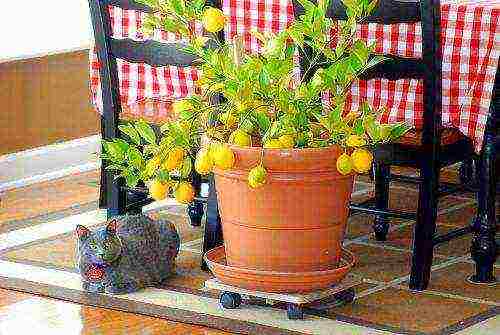
Growing lemon can be done at home
Lemongrass are native to southern countries with warm and humid climates. Therefore, the main task of the grower is to ensure similar microclimatic conditions in the house or apartment.
Why is lemon grown at home?
There are several advantages to breeding lemon crops at home. The main one is the fragrant healthy fruits that the plant produces annually. In addition, placing a lemon on a windowsill can be an interior decoration.
You can grow lemon at home in a pot or tub. The pot is more suitable for dwarf plant varieties, the tub is useful if a large tree is grown from a stone. With a sufficient amount of heat, moisture and light, indoor lemon can reach one and a half meters in height and produce up to 150 fruits per season. It is very difficult to achieve such results, but taking into account all the features of care, it can still be done.
Another advantage of growing lemon is the beautiful appearance of the tree. He has a dense and always green crown. During the flowering period, the plant throws out beautiful flowers. They are often covered with mighty green leaves. The only exception is the Ponderosa lemon, whose branches are thin and resemble a spreading bush. Despite the external weakness, the twigs can withstand up to 50 fruits. This decorative tree can be grown on a windowsill, since it does not take up much space.

Lemon bush can produce up to 50 fruits
General features of growing lemon at home
Lemon is a thermophilic tree. Lack of heat affects the fact that the plant grows poorly, gets sick or dies. If you decide to put a pot on the window, then you must:
- Choose south or east side. The plant should receive a lot of sunlight.
- On sunny days, the tree is placed in the shade, and on cloudy days, it is illuminated with fluorescent lamps.
- In the summer, take the plant out to the balcony or loggia. There it receives more oxygen and solar energy. And only by the fall it is brought back to its original place. In winter, you should monitor the temperature indicator, which should not fall below 10 degrees.
Special attention should be paid to the quality of the soil and the pot. The fact is that lemons have an individual nutritional system. They get water not through ordinary hairs on the roots, but through fungi in the soil. The connection of the house plant with the mycelium of the fungi is sensitive to external factors. It can be easily disturbed by a lack of oxygen, improper watering and sudden changes in temperature.
Before growing a lemon tree, you should take care of a suitable soil. Plant lemons in loose soil types that are pH neutral. It is best to plant citrus in ready-made soil purchased from a specialized store. If the indoor lemon is placed in a self-made substrate, it is important to take into account the proportions of humus, turf and sand. The soil with meadow turf, leafy soil, humus and sand is also popular.
Mistakes in care lead to the fact that the lemon tree at home dies from aridity or excess moisture, poor living conditions or pests.
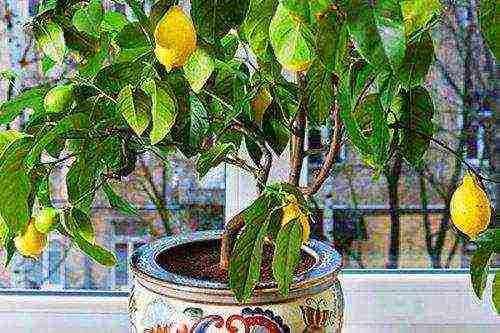
Lemon prefers the sunny side of the room
Planting lemon
For small plants, a clay pot is suitable, for large plants it is better to use a wooden tub, which is considered the best option for placing citrus fruits. Natural material allows oxygen to pass better to the lemon roots. Before placing the planting material in the pot, it should be inspected for damage. The planting process itself is simple:
- The root collar is buried 5 cm deep.
- The container is filled with soil almost to the very top. Better if there is a space of 1-1.5 cm between the edge of the pot and the soil.
- After planting, the seedling is sprayed with water and watered with a solution of potassium permanganate.
The planted tree is left on the windowsill. A young plant needs a lot of light and warmth. On hot days, it is better to create partial shade, which will save you from burns. It is not worth changing the place for the pot, the lemon does not like moving. Occasionally, you can turn the tree with darkened leaves towards the sun for even heat.
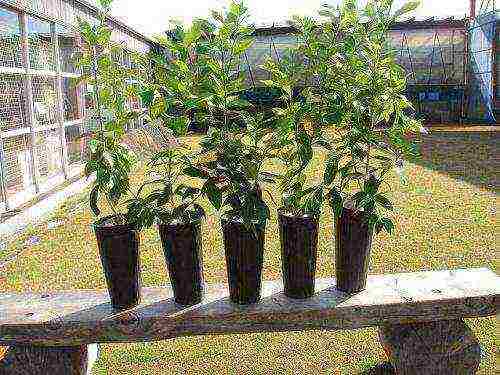
Lemon seedlings are sprayed with water after planting
Growing lemon from seed
If you decide to germinate a varietal lemon from the seed, you should know the peculiarities of its cultivation. This process takes much longer than planting seedlings. To find out how long it takes for the seeds to germinate, you need to take into account the following features:
- The sprout breaks out of the soil 2 weeks after planting. Sometimes it takes more time (up to one month).
- Citrus buds require greenhouse conditions, so the pot with a bone is covered with a cut plastic bottle or wrapped in plastic wrap. Inside such a cap, the humidity is several times higher than in an open space, and the transparency of the bottle allows the ascending sprouts to receive sunlight. In a homemade greenhouse, watering should not be overused. The soil already gives off moisture to the allotted space of the greenhouse, so it should only be sprayed.
- When a small stalk has broken through, it is taught to indoor conditions by removing the greenhouse cap for 1-2 hours a day.
- Transplanting into a large pot occurs only when 4 leaves appear on the sprout.
Growing lemon in a greenhouse will also work for mature seedlings.With the correct organization of climatic conditions, you can do without it. It is also not worth rushing with feeding.
Until the citrus root system is fully formed, any external additives will be perceived by the tree as a poison. It is best to do top dressing in the spring or summer, but not earlier than three months from planting.
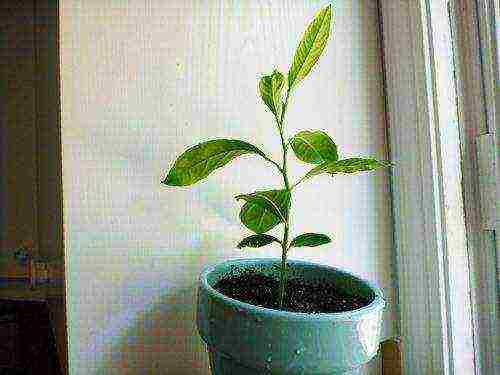
Growing a lemon from a seed will take quite a long time.
Lemon watering
Growing a lemon at home is not an easy task, often a lemon does not survive for several months. And one of the reasons for this is improper watering. Providing proper home care is essential for the plant to grow healthy and strong. How to properly water
- Provide moderate watering with settled water once a day. You can water it once twice a day (you need to monitor the condition of the soil).
- Water the lemon 2 times a week in winter.
- Drain the accumulated water in the sump immediately after watering. Plant roots can rot from excess moisture.
- Sprinkle lemon leaves daily with warm water. It is especially important to do this in winter, when the air becomes dry from the operation of heating systems.
Experienced growers advise beginners to find a moisture balance: avoid overflow and lack of moisture. With a lack of it, the leaves of any kind of lemon begin to turn yellow. If watering is not done in a timely manner, the microza and the plant die. If yellowed leaves are detected, the lemon should be sprayed with a weak solution of potassium permanganate.
We must not forget about the benefits of a warm shower. Like everything standing motionless in a dwelling, a lemon is covered with a layer of dust and dirt. It should be washed off as dust interferes with the process of photosynthesis. Bathing of the plant is carried out no more than 1 time per month.
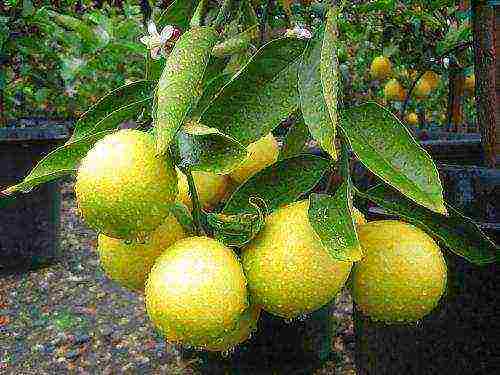
Dust should be regularly washed off lemon leaves.
Lemon fertilization
Recommendations on how to care for a lemon also apply to plant nutrition. Citrus fruits are sensitive to fertilizers. The preparations must be constantly changing, because when using one fertilizer, the pH of the soil can change to an acidic or alkaline side. In such soil, lemon does not ripen, it grows for a long time, gets sick and dies. To avoid this, you should:
- Choose only mineral formulations for fertilization.
- Apply fertilizers from March to October at intervals of 2-3 weeks. For young plants, it is enough to carry out the procedure once a month and a half.
- Combine top dressing with watering in the summer.
- In spring and autumn, feed the plant only after watering. Fertilizer is applied at least 2 hours after the soil is moistened.
- In winter, fertilize once.
Unlike complex mineral fertilizers, not all organic substances are suitable for lemon. The most effective solution is a weak solution of manure with water (1/6) and an extract from wood ash. A special infusion of birch and quinoa leaves is popular.
Some citrus fruit owners are faced with the problem of flowering. When flowers do not appear on the crown among the ripening leaves, this indicates poor feeding. Why does the plant react this way? The fact is that the lemon does not have enough strength to bear fruit. And a change in fertilizer will help him cope with this problem.

From quinoa, you can prepare an infusion for fertilizing lemon
The importance of pruning
The need for pruning is due to decorative and sanitary features. Its shape and scheme most often depend on the purpose of growing the tree. Small ornamental plants do not need sprawling large branches, so they are cut as much as possible, making the crown compact. For citrus fruits that bear fruit, the rule of balancing branches and shoots applies. The most common pruning method is pinching.
It begins after the lemon has reached the age of one year, with preliminary pruning of the main shoot. It is best to leave it at 30 cm in length. This is necessary so that the lateral buds on the tree begin to sprout.
Only after the lemon gets stronger and gives new branches, they should be pinched. 3-4 leaves remain on each branch. This pruning method allows the tree to grow strong, able to hold and ripen fully.
It is important to prune old dead branches. The lemon spends its powers on them, but it will not work to revive them. Therefore, it is better to rid the lemon of the extra load. Those shoots that grow inside the crown also lend themselves to pruning. They most often prevent neighboring branches from developing and getting enough sunlight.
Lemon harvest
Enjoy the ripe lemon fruit grown on your own balcony or windowsill only with the correct formation of the blooms. Weak immature plants can throw out a large number of flowers in the second year of life. You cannot leave them. The structure of the tree cannot withstand a heavy load, and the lemon will die, giving all its strength to the fruit. To grow a large crop, you should:
- In the second year of the lemon's life, leave 2 flowers on the whole tree or completely remove the inflorescences.
- During flowering, carefully monitor the health of the tree, protect it from drafts and carry out all the features of caring for it.
- Know the rule of forming inflorescences - there should be 10 leaves for 1 fruit. All other ovaries are removed.
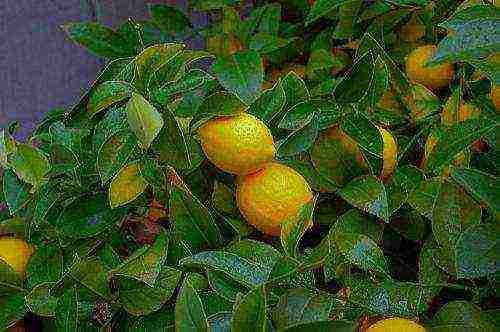
Lemon harvest can be expected 4-5 years after planting.
Do not expect high fertility rates from a houseplant. The tree grows and develops very slowly. Any human error can delay the appearance of blooms. You should constantly monitor the condition of the lemon and feed, cut and water it in a timely manner.
Some citrus fruit owners get their first good fruits within 4-5 years. Their number rarely exceeds 5–8 pieces. A larger harvest will have to wait longer. The tree reaches its maturity only by the age of 8–10 years, and at home, the lemon lives up to 40–45 years.
Transplant features
Some citrus owners are faced with the problem of the rapid death of the plant. If its cause depends on watering and fertilization, then the tree suffers from an incorrectly selected pot. Too much capacity causes root rot. It is better to use pots commensurate with the root of the plant and replant the tree only when it becomes cramped. It is best to increase the space gradually, while controlling the growth of the tree's roots.
We must not forget about the proper access of oxygen to the roots. It is better to install the pot on a pallet with a gap so that air can penetrate into the ground. Place a lining of stones or wood under the bottom of the pot.
After transplanting, the citrus is returned to the same place where it stood before. Any change in the environment is bad for the health of the plant. It can hurt and even die. If you want to turn the tree with the darkened side towards the sun, then you should change the angle by no more than 10 degrees. Only in this way will the lemon grow strong and healthy.
Subscribe Be aware of new products on our site
Lemons from the windowsill
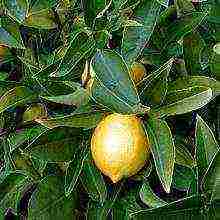 Greetings, dear readers!
Greetings, dear readers!
Eating exotic fruits, probably every second person visited the following question: is it possible to grow fruits of the southern regions in our conditions? Answer: yes, it is possible, if the growing conditions are brought closer to their climatic standards. Of course, not every fruit will be able to grow, but, for example, the familiar and beloved lemon, in relation to which such thoughts most often creep in, is quite possible.
Let's talk about growing lemon on the windowsill and about caring for the plant.
For home cultivation, lemon is like no other fruit. Firstly, it is perennial, and secondly, it blooms profusely, which, in turn, with proper care, in addition to interest and decorative function, will also bring you its own exotic harvest.The very procedure for growing lemon in non-standard conditions for it is quite simple. The story will go about her in our article.
To embody your idea with lemon, you only need a bone from it, a pot, earth and a little perseverance. For lemon seeds, it is better to choose large seeds. It is believed that they will sprout better and faster. Do not tighten with planting, since dried seeds are difficult, take a long time or do not germinate at all. Further, it will be necessary to carry out the old and familiar rite of soaking seeds in an epin solution. The seeds placed in this solution for a day are guaranteed to provide early shoots and vigorous, active growth of the plant at the initial stage. Many will ask: why are several seeds taken? Answer: for confidence in seedlings. It is better to remove excess sprouted plants than to spend time waiting and not achieve seedlings. Pay attention to the jubilee lemon.
After the preparation and processing of the seeds is completed, we plant them in well-loosened moist soil. The planting depth of lemon seeds is about 1.5 cm. Their appearance should begin at 3-4 weeks, but for now we put the planted seeds in a warm place. Watering during this waiting period is not necessary, you can only slightly moisten the ground by spraying. Only after the emergence of seedlings and the formation of a second pair of leaves on them, the plants are seated in different pots or they are completely removed as unnecessary, leaving one copy they like.
Now that the seedlings have been obtained, they must be preserved and allowed to grow stronger. To do this, you must follow some care rules. First, to ensure all further growth of the lemon tree at a comfortable temperature for it. In summer, its readings should be about 20-22 degrees, in winter 10 is enough. At the same time, it is necessary to prevent drying out or waterlogging of the soil. Secondly, do not allow the plant to overheat and burns, which will be fatal for the lemon. To ensure this, perhaps, the absence of direct sunlight and the inadmissibility of close proximity near heating devices. He does not like lemon and drafts, so such places should be avoided. Caring for the leaves of the lemon tree is carried out with just one spraying, it is not necessary to wipe them, it is very sensitive to this. Water for spraying and irrigation must be settled.
In general, lemon care is common and unremarkable. You can pamper it, like any other plant, with fertilizing using mineral-based fertilizers. In the summer, this procedure must be done several times a month. In winter, one feeding every 3-4 weeks is enough.
Expecting flowering and fruiting, it will be useful to use a special phytolamp and a humidifier. The combination of the atmosphere created by these devices will contribute to the rapid flowering and active growth of lemon fruits. These are the rules, perhaps, and all the care of the lemon.
With such simple actions you can carry out growing lemon on the windowsill and get a real lemon tree that will bear fruit all year round and delight you with its fruits for the next thirty years. A southern plant in your home, will surprise guests and delight you with tea with your own grown lemon. See you!
Lemon (Citrus limon) is a representative of the genus Citrus, which belongs to the Rutov family. The plant, whose homeland is considered to be China, India and the Pacific Islands, is today cultivated in many subtropical countries. And where the climate does not allow, the lemon tree is grown as a houseplant. A compact evergreen tree can be grown from a lemon seed, which will not only decorate the interior, but also delight you with delicious, healthy fruits. Essential oils and phytoncides secreted by lemon leaves will help fight stress and nervous tension.
Lemon varieties

In countries with a subtropical climate, lemons are grown outdoors, while in Central and Eastern Europe, the climatic conditions for the lemon tree are not suitable, and here it is cultivated as a houseplant.
In nature, lemon is an evergreen shrub. Home-grown lemon is also a small shrub with thorns on the trunk and dense leaves with a dark green, glossy surface.
The result of a long, hundreds of years of breeding has resulted in the emergence of many varieties of lemon.
- Pavlovsky. It is highly popular with Russian gardeners. An unpretentious lemon tree grows up to 1.5 m, begins to bear fruit in the third year of life and gives an average of 15 lemons per year.
- Ponderosa (aka Canadian). A low-growing tree, not exceeding 1 m in height. Blooms early enough and bears few fruits - no more than 5 pieces.
- Lunario (aka four-season). A medium-sized plant producing fruits with a weak taste. This variety is cultivated mainly in Egypt.
- Libson. A tree 1.5 m high with powerful thorns gives large, fragrant fruits (on average - 15 pieces). Blooms for the first time 3 years after planting.
- Maikopsky. Differs in ease of care and high yield, grows up to 1.3 m. It is especially popular in the Krasnodar Territory.
- Corsican (aka hand of Buddha). An exotic variety, the fruits of which are used in cooking mainly for the preparation of candied fruits. It grows to a height of 1.5 m and bears about 10 fruits annually.
- Anniversary. The most suitable variety for growing at home, hardy and requiring the least attention. It grows up to 1.5 m in height and bears fruit well. But the fruits have a thick skin and a weak taste.
- Meyer (aka Chinese dwarf). The variety, bred by crossing a lemon and an orange, is a low-growing bush no more than 50–70 cm in height. But the plant is quite whimsical, it often gets sick, and requires additional lighting in autumn and winter.
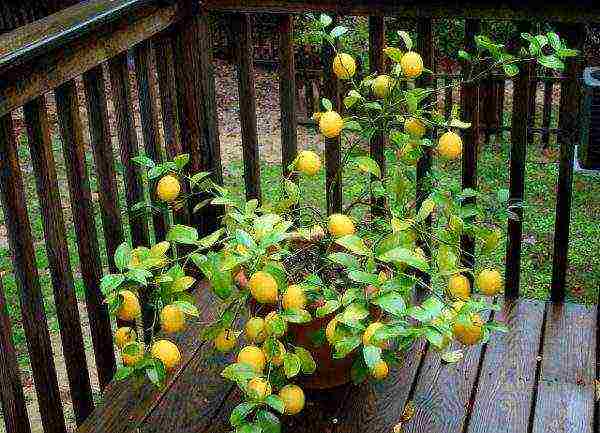
Lemon Meyer is characterized by a high yield and gives many fruits of an unusual taste, but due to whimsicality and capriciousness it is not often grown at home.
Care features
Indoor lemon does not react well to permutations, so it is better to decide on the choice of a suitable place right away. After moving to another place, the lemon tree begins to shed its leaves, and if you disturb the plant during the flowering phase, you can not wait for the harvest.
Lighting
The lemon tree loves light, but it also tolerates partial shade. The southern windows are not suitable for the plant, since with excessive access of light, the growth of the vegetative part is activated, and the phase of flowering and fruit formation is inhibited. On the north side, the tree, on the contrary, will not have enough light. As a result, the leaves will grow slower and the fruit will be too sour. Windows facing east or west are best suited for lemon.
For a symmetrical crown formation, a flowerpot with a lemon tree needs to be turned once a week around its axis by about a quarter of a turn.
Temperature
The optimal summer temperature for a lemon tree is from 18 to 20 ° C. In winter, it is recommended to grow the plant at 15-18 ° C. temperatures are fatal for him.
Air humidity and watering
The lemon tree loves humid air. It can be sprayed all year round and the pot should preferably be placed on a pallet filled with wet gravel. The plant does not tolerate stagnation of water in a pot, therefore, the optimal watering regime in winter is once a week, and in summer - twice in 7 days, but abundantly.
Priming
Lemon loves a nutritious soil with a sufficient content of mineral and organic substances. Suitable for planting a plant:
- ready-made soil for all citrus plants;
- universal earth for indoor flowers;
- humus soil;
- composition of sheet and sod land, humus, river sand and charcoal.
The soil should be soft, loose. And so that the water in the pot does not stagnate, you need good drainage from expanded clay and brick pieces at least 2 cm thick.
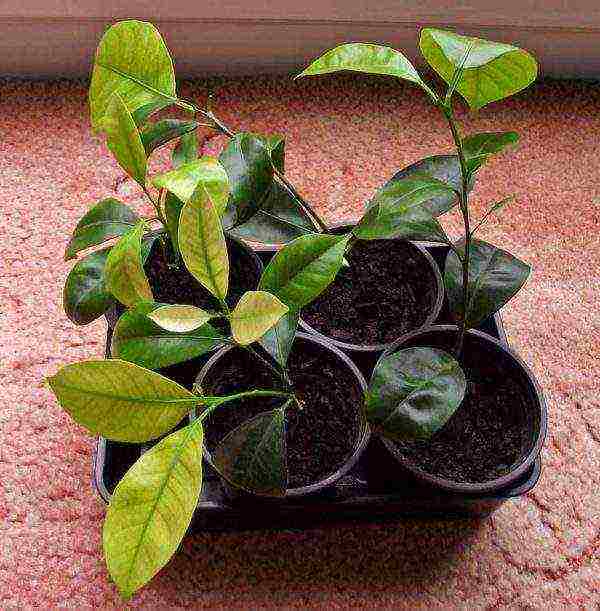
The soil for growing lemon should be light, moisture and air permeable, with a pH level in the range of 6.6-7.0.
Fertilization
You need to feed indoor lemons constantly. In summer, fertilizers are applied only in liquid form every week, the rest of the time - at least once every 30 days. It is recommended to alternate mineral fertilizers with organic fertilizers. Can be used:
- weak solution of mullein, bird droppings;
- water with the addition of nettle infusion (leave for 2 weeks);
- eggshell infusion (only from the fourth year of plant life).
Pruning
The grown lemon from the seed grows quite large, with long branches. The plant takes up a lot of space, while its yield decreases. To achieve an acceptable crown size, pinching and pruning is carried out.
The first pinching is carried out when the main shoot grows to 20-25 cm. The next pinching is carried out at a height of 15-20 cm from the previous one. There should be 4 buds between the two nips, which in the future will give the main branches. The pinching of the shoots of the first row is carried out every 20-30 cm, and when the branches become firm, they are cut 5 cm below the pinching point. The pinching of the next shoots is carried out so that they are 5 cm shorter than the branches of the previous row. The formation of the crown is completed on the shoots of the fourth row.
Pruning is usually done in the spring, before flowering begins. The roots of the lemon tree also need to be pruned during transplantation, otherwise the root system will stop developing normally and the lemon leaves will become pale.
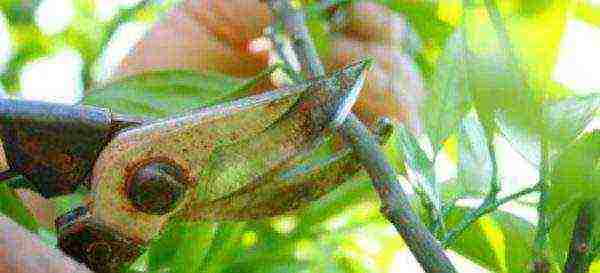
If necessary, during pruning, it is necessary to remove weak shoots and twigs growing inside the crown.
Transfer
A young, recently appeared lemon from a stone should be transplanted annually, or better - twice a year (in February and June). Lemons over 5 years old are transplanted every three years in the spring.
Each new pot should be 3-4 cm larger than the previous one - both the root system and the crown of the lemon tree grows very quickly. When transplanting, do not sprinkle the root collar with earth (the junction of the stem with the roots).
The roots of a young lemon are very sensitive and vulnerable and require extremely careful handling during transplantation.
Banding
Ringing is a procedure that helps speed up the appearance of fruits. It consists in the following. The base of the trunk with one or two adjacent shoots is wrapped with copper wire so that it squeezes a little into the bark (but not much!). As a result, nutrients begin to accumulate at the ringing site, and the formation of fruit buds begins on the lemon. The wire is removed six months later, and the transferred bark is treated with garden varnish, wrapped with an elastic tape.
Reproduction
At home, lemon can be propagated in three ways:
- seeds (bones);
- cuttings;
- layering.
Seeds
Many people believe that the grown lemon from the seed does not bear fruit. But this is wrong. With proper care, a seed-grown plant begins to bear fruit in 5-8 years.
For those who do not know how to plant a lemon from a stone, it is worth saying that even a novice gardener can cope with this simple process. The main task in seed reproduction is to choose the right planting material.
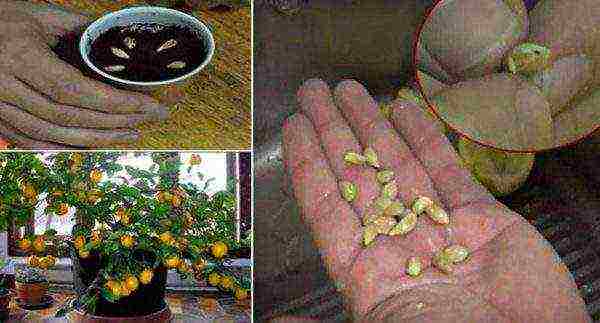
Due to the simplicity of obtaining planting material, the seed method of lemon propagation has become the most common.
Fruits must be of good ripeness, with an even surface and uniform color, without dents, spots on the peel and other damage. Lemon seeds should also be large and intact. It is better to take planting material from several fruits, and then select the most viable seeds.
The procedure for growing lemon from seed includes several stages.
- Prepare small long pots with a drainage layer and a soil substrate consisting of flower soil and peat.
- Immediately after removing the seeds from the fruits, they are treated with a sodium humate solution - this will accelerate germination.
- The treated seeds are planted in the ground at a distance of 3 cm from the walls of the pot and to a depth of 1.5–2 cm.
- The containers are covered with polyethylene until the first shoots appear, they are kept at a temperature of 20 ° C. Lemon seeds germinate for a very long time - from two months to six months.
- Of the sprouts that appear, the healthiest and strongest are chosen, covered with glass jars to create the desired microclimate. The containers are placed in a place with sufficient lighting, ventilated every day.
- When the first leaves appear on the sprouts, they are seated in separate pots.
- In larger containers, seedlings are planted when their height reaches 20 cm.
It is necessary to plant seeds in one container at a distance of at least 5 cm from each other, but it is better to take separate small containers (for example, disposable cups) with drainage holes.
Cuttings

When propagated by cuttings, lemon begins to bloom in the third or fourth year.
Reproduction by cuttings is carried out in the spring (in March-April), includes several stages.
- In a well-fruiting plant, cut off 10 cm of a fairly hard and at the same time flexible cuttings (about 5 mm thick) with 2-3 living buds. An oblique cut is made under the sheet with a sharp knife. The upper cut should be 1.5–2 cm above the kidney.
- The stalk is treated with a root system growth stimulator (root preparations, heteroauxin, sodium humanate), placed in water or in moist soil by 2-3 cm.
- The stalk is covered with polyethylene so that it does not dry out.
- After the roots appear (on average after 2 weeks), the cutting is moved into a small pot, kept at a temperature of 20 ° C in a place where there is sufficient access to light. Spraying the cuttings is carried out twice a day.
- To accustom the plant to indoor air, the film is opened daily, first for an hour, then gradually the time is increased.
- After 2 months, when the plant is fully rooted, it is transplanted into a larger pot (diameter 10 cm) with nutrient soil, placed in a permanent place.
If the selected stalk is supposed to be placed not in water, but in soil, you need to prepare a container with a soil substrate:
- cover the bottom of the container with a drainage layer (clay shards, porous vermoculite, expanded clay);
- cover the drainage with a nutritious soil with a layer of 5 cm (you can take equal parts of the forest and sod substrate, a sixth of the sand);
- pour a mixture of equal amounts of sand and sphagnum moss on top (can be replaced with high-moor peat).
When several cuttings are planted in one container, a distance of at least 5 cm is left between them. Immediately after planting, the cuttings should be sprinkled with warm water and covered with foil.
Taps and inoculations
This method of reproduction is rather complicated and laborious, and therefore is rarely practiced by amateur gardeners. The plant is more often grafted by professionals for the earliest possible receipt of fruits. Usually lemon blooms in the year of grafting, and after another year it gives the first fruits.
In general, the vaccination procedure is carried out as follows. A kidney is cut from an older lemon that has reached the age of 2-3 years. She is planted in a cut of a younger plant. Citrus is best planted in May or late August.
Bloom
Depending on the variety, the color of the flowers can be white, pink or red. To get fruit, it is important to properly care for the plant during flowering and follow a number of rules:
- during the flowering phase, do not rearrange the lemon tree to another place;
- pollinate the plant on your own (with a cotton swab, carefully transfer the pollen to the stamens);
- remove excess flowers in a timely manner.
At the first flowering, you need to remove half of the buds.It is best when there are 15 to 25 leaves per fruit.

From the moment the ovary appears to full maturity of the fruit, it can take more than 9 months.
Growing problems
The grown lemon from the seed is not picky about the conditions of detention, but it is often exposed to diseases and pests. One of the most common problems is yellowing and falling foliage. The reasons for this may be:
- watering with cold water;
- excessive watering;
- insufficient lighting;
- heat;
- drafts;
- change in soil acidity;
- lack of nutrients.
If yellowing of the leaves is observed in a newly acquired plant, this is normal and is associated with acclimatization.
Pests
The lemon tree can be attacked by spider mites, scale insects, and aphids. In this case, the leaf plates curl, become covered with light spots, and a small cobweb is noticeable on the plant. Periodic warm showers and spraying of leaves in the heat help to prevent the attack of pests. If parasites have appeared on the plant, treatment is carried out with the preparations Clean Sheet and Aktara. Processing is carried out twice with an interval of 10 days.
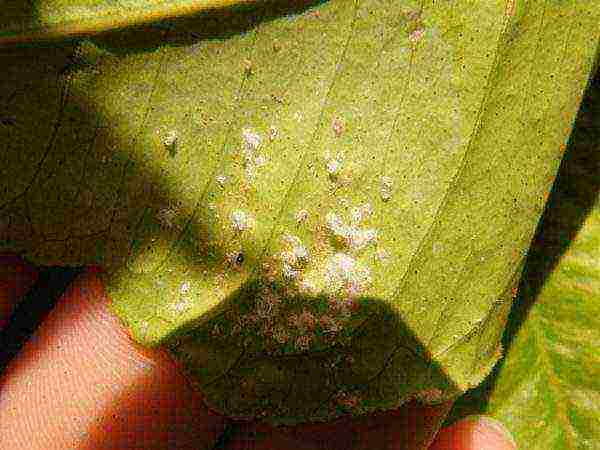
Defeat of the lemon tree by aphids.
Diseases
- Gommoz. An infectious disease that affects the trunk of a tree. At the bottom, cracks appear on the bark, and a dark, sticky liquid begins to seep through the damage. After a while, the lemon withers, putrefactive spots appear at the sites of damage. You can save a lemon tree by transplanting it into a pot of fresh soil. Before planting, you should clean the roots and damaged areas, treat them with copper sulfate. It is possible to cure a tree from gommosis in rare cases, more often the plant dies.
- Late blight. It manifests itself in the same way as gommosis. It often affects young plants, while an oily brown ring forms on the trunk. For treatment, the affected area must be treated with copper sulfate.
- Root rot. The disease is characterized by damage to the root system, while the lemon begins to shed its leaves for no apparent reason. If you suspect root rot, you need to remove the plant from the pot, examine the root system, remove damaged roots, and treat healthy roots with a growth stimulator. After this, the tree must be planted again. Caring for a lemon until it is fully recovered includes minimal watering, ensuring adequate lighting, and regularly wiping the leaf plates with a damp cloth.
- Tristeza. A viral disease in which the bark of a tree dies off. This disease, unfortunately, is not treatable.
- Sheet mosaic. Characteristic patterns appear on the leaves of the lemon tree. It is impossible to cure the disease, but with careful care, leaf damage becomes less noticeable.
- Citrus Cancer. A refractory condition characterized by dark brown spots on the leaf blades. The disease leads to the rapid death of the plant.
It is not difficult to grow a lemon from a seed or cuttings. But fruiting can only be achieved with proper and regular plant care. The lemon tree will be a wonderful decoration for any interior, during the flowering period it will fill the room with a wonderful aroma. And if you pay enough attention to the plant, the long-awaited fruits will be the reward.

